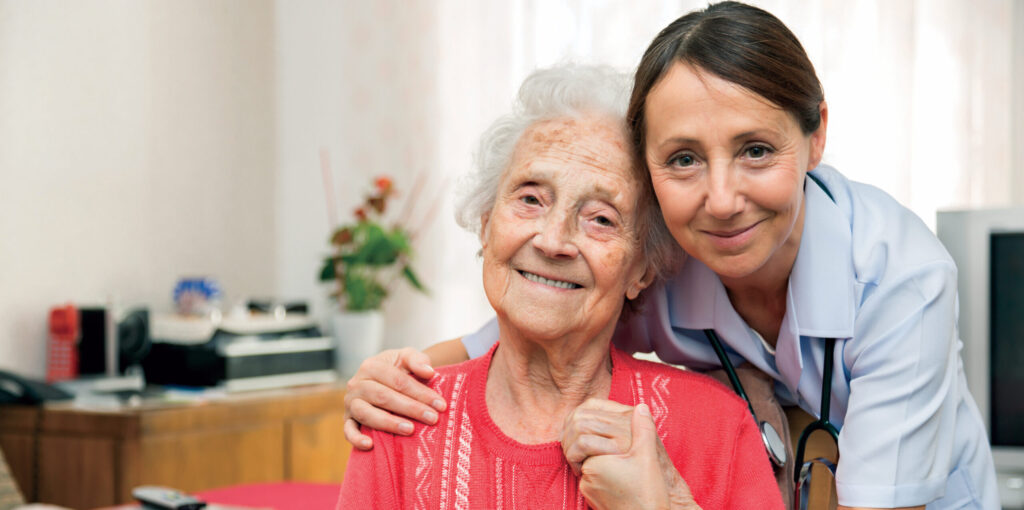Falls pose a significant risk to individuals living with dementia, often resulting in injuries that can lead to a decline in overall health and well-being. As dementia progresses, people living with Alzheimer’s disease and other forms of dementia can often experience impaired balance, coordination, and judgment, making them more susceptible to falls.
According to a new research study published in Alzheimer’s and Dementia, a journal of the Alzheimer’s Association, nearly half of older adults with dementia experience falls. Of more than 5500 participants in the study, 45.5% of those with dementia experienced one or more falls compared with 30.9% of their peers without dementia. The study also identifies multiple risk factors for these falls. Vision impairment and living with a spouse were among the strongest predictors of future fall risk among participants living with dementia.
Falls are also a leading cause of hospitalization among those with dementia. Persons with dementia are more likely to experience negative health consequences, such as delirium, while in hospital compared to those without dementia. This increases the likelihood of people with dementia being discharged to a nursing home rather than returning home after a hospital stay.
Preventing falls is crucial to maintaining a higher quality of life for those with dementia. As a caregiver of a person with dementia, you may wish to better understand what prevention measures you can take to help your loved one.
By prioritizing fall prevention measures, caregivers can enhance the safety and quality of life for individuals with dementia, enabling them to age gracefully and independently. Below are some effective tips and strategies to create a safer environment for individuals dealing with cognitive decline.
- Environmental Modifications:
- Clear Pathways: Ensure that living spaces are free of clutter, loose rugs, and obstacles. Create clear pathways to allow individuals with dementia to move around safely without the risk of tripping.
- Proper Lighting: Adequate lighting is essential for preventing falls. Install bright and consistent lighting throughout the home, particularly in hallways, staircases, and bathrooms. Consider motion-activated lights to enhance visibility during nighttime.
- Secure Handrails: Install handrails in key areas such as staircases, hallways, and bathrooms to provide additional support and stability. Regularly check for any loose or damaged handrails.
- Personalized Care:
- Footwear Awareness: Encourage individuals with dementia to wear comfortable, well-fitting shoes with non-slip soles. Avoid shoes with laces that could lead to tripping.
- Regular Exercise: Engage in light exercise routines to enhance strength, balance, and flexibility. Consult with healthcare professionals to create a personalized exercise plan suitable for the individual’s abilities and needs.
- Regular Health Check-ups: Schedule regular check-ups with healthcare providers to address any underlying health issues that may contribute to the risk of falls, such as vision problems or medication side effects.
- Supervision and Assistance:
- Caregiver Support: Ensure that caregivers are well-trained to provide appropriate support, supervision, and assistance. This includes being aware of the individual’s limitations and responding promptly to their needs.
- Assistive Devices: Introduce assistive devices such as walking aids or wheelchairs when necessary. Ensure that these devices are properly fitted and regularly maintained.
- Cognitive Support:
- Memory Aids: Use visual cues and reminders to help individuals remember their surroundings and daily routines. This can reduce confusion and decrease the risk of falls.
- Structured Environment: Maintain a consistent and predictable environment to minimize disorientation. Avoid rearranging furniture or making sudden changes to the living space.
- Education and Communication:
- Raise Awareness: Educate family members, caregivers, and friends about the challenges individuals with dementia face. Encourage open communication to address concerns and implement effective fall prevention strategies.
- Monitor Changes: Stay vigilant for any changes in behavior, mobility, or overall health. Regularly reassess the living environment and adapt preventive measures accordingly.
Preventing falls in individuals with dementia requires a comprehensive approach that considers both the physical environment and the unique needs of the person living with dementia. By implementing these tips and fostering a supportive and informed caregiving environment, caregivers are instrumental in helping to significantly reduce the risk of falls and enhance the safety and well-being of those living with dementia.
There are also several excellent resources and books available that provide practical guidance on modifying homes for individuals living with dementia to prevent falls. A Caregiver’s Guide to Dementia:: Using Activities and Other Strategies to Prevent, Reduce and Manage Behavioral Symptoms, by Laura N. Gitlin and Catherine Verrier Piersol, covers a range of topics, including home safety and fall prevention strategies. If you want to delve into the architectural and design aspects of creating spaces that are supportive for individuals with dementia, you may wish to consult Designing for Dementia: Creating Living Environments that Allow People with Dementia to Thrive by Elizabeth C. Brawley. AARP provides a HomeFit Guide that offers practical tips for making homes more accessible and safe for individuals of all ages, including those with dementia.
Overall, it is important to ensure that the information you gather aligns with the specific needs and circumstances of the person you are supporting with dementia. The safety tips above combined with insights from books, online resources, and professional guidance, can ensure you create a safer and more supportive home environment and prevent the likelihood of devastating falls.









